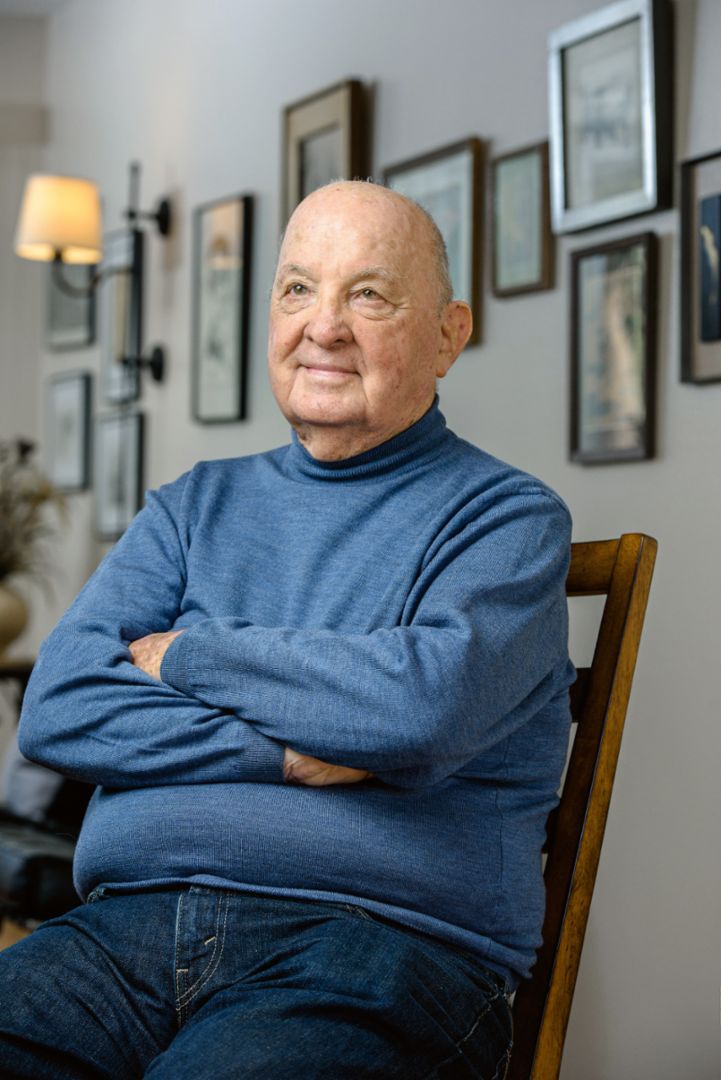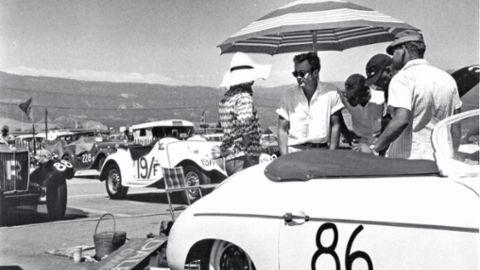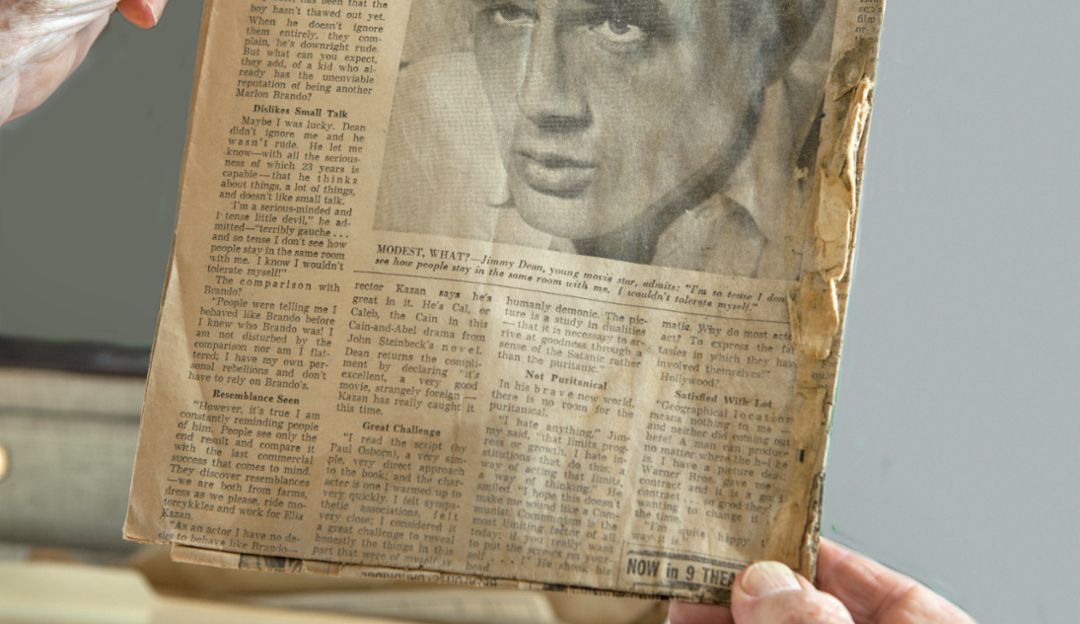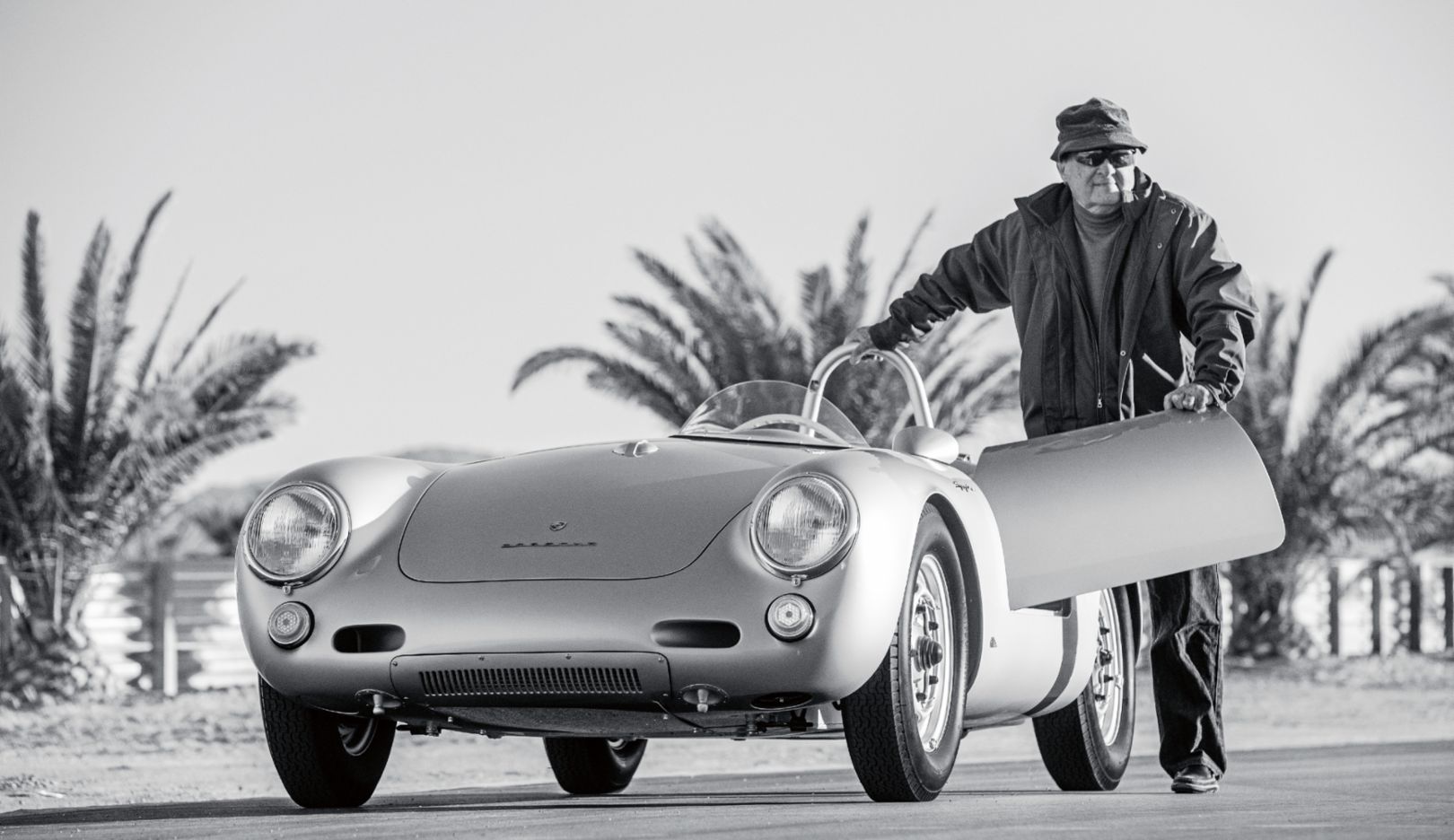Unforgotten
Porsche stopped producing the legendary 550 Spyder sixty years ago. That was also when Lew Bracker entered his last race. For this American amateur racing driver, the sports car was an integral part of his friendship with James Dean.
Organisation: Sven Rueddigkeit

Lew Bracker carefully opens the door of the silver Porsche 550 Spyder, slides smoothly into the seat, and places his hands on the wheel. He looks out over the racetrack on the grounds of the exclusive Thermal Club in Southern California, his gaze continuing out toward the Mecca Hills in the distance. “I feel like I’m home,” he remarks. Then he takes a reminiscent look back.
Bracker’s last race was sixty years ago.
Although Bracker’s last race as an amateur driver was sixty years ago, those six decades seem to have collapsed into a second. The car, which belongs to Costa Mesa’s European Collectibles dealership and is worth millions of dollars, has catapulted him back into the 1950s. Now eighty-nine, Bracker spent his younger days driving sports cars from Zuffenhausen on the roads of Southern California together with his best friend Jimmy—otherwise known as James Dean.


Small talk in the pit lane:
James Dean and Lew Bracker chatting with their colleague and Speedster driver Dale Johnson shortly before a training lap. Johnson was a rival to be reckoned with in Jimmy’s three races.On September 18, 1955, Bracker was driving home when he spotted a 550 Spyder for the first time at Competition Motors in Hollywood. He told Jimmy about the featherweight silver racing car that same evening. Bracker and Dean, who were both in their mid-twenties, loved to talk about racing, cars, and especially Porsches. Three days later Dean drove up to Bracker’s home in that very same silver Spyder. Dean had traded his white Porsche 356 Speedster for it. “I promptly traded my red 356 Speedster for Jimmy’s,” says Bracker.
Nine days later, on September 30, 1955, James Dean was dead. He died in the Spyder as he drove from Los Angeles to a race in Salinas, about six hundred kilometers to the north. That was just six months after Dean’s first movie, East of Eden, had made him a star. Now he would become a legend, and the Spyder, in contrast, would acquire a tragic renown.
In June of 1954, before Dean’s leap into fame, he and Bracker had met at the Green Room, a restaurant on the grounds of Warner Brothers Studios. Bracker is convinced that if Dean were alive, the two of them would still be best friends. In addition to their love of cars, they shared many other interests, such as music and movies. And they were busily hatching plans. Dean, who did not trust many people in Hollywood, wanted Bracker to produce his films. They were also planning to open a restaurant and a Porsche dealership. They already had a name for it, recalls Bracker: James Dean Motors.
Bracker had been enamored of big American cars. His first automobile was an Oldsmobile convertible, and his second a Buick Century. But then he became inspired by Dean’s enthusiasm for the uncompromising sports cars from Germany. The two often took their Speedsters on nighttime joyrides along Los Angeles’s winding Mulholland Drive and through canyons outside the city, which saw little traffic in those days.
Dean was also responsible for igniting his friend’s passion for motorsports. Bracker’s first contest was at the Santa Barbara Road Races in early September 1955—in his red Speedster and wearing Dean’s helmet. “He loaned me his helmet, but it was clear that it was a gift—he signed his name on the left-hand side,” says Bracker. Dean himself was a newcomer to motorsports. Because a clause in his contract with Warner Brothers required him to refrain from the sport for several months, he would enter only three races in his life. Bracker would go on to enter a good forty of them until 1957, in different Porsche models that always bore the starting number 113. “Jimmy and I wanted to drive with the number 13, but both the California Sports Car Club and the Sports Car Club of America were superstitious and wouldn’t issue number 13 to anyone. So Jimmy settled for number 130 and I for number 113,” Bracker says.

Memories:
Lew Bracker with an old newspaper article about James Dean in his hands.Bracker won six races, posted second- and third-place finishes five times each, and for a while was the driver with the best record in the West Coast racing scene.
Bracker did not officially drive for Porsche but was supported by local Porsche dealers who were eager to raise the young brand’s profile in California. “The Carrera had to win, because it wasn’t winning; it was a dud, really, when they brought it out. In those days, the cars that won on the road-race circuit sold. That was the best advertising.” Bracker did his best to help, such as when he convinced Porsche to offer the Carrera Speedster in black. “The Porsche people didn’t want to, but I insisted,” he says with a smile. “I just kept saying, ‘I want black; it’ll be very striking and distinctive.’” The walls of Bracker’s apartment in Palm Springs are lined with framed photos of him as a young man in action on various tracks, driving a black Carrera and wearing a black racing suit and helmet. “It goes back to Jimmy, as my whole racing thing does: before he died he had bought a black racing suit. I thought, ‘Boy, that’s really dramatic.’”
The race-car driver that Bracker most wanted to emulate was Argentina native Juan Manuel Fangio, who won a series of Formula One world championships—and Bracker succeeded in doing so. “I always went deeper into corners than other drivers, but never hit the barriers, never spun out. I felt the fastest way was the smoothest way,” he says in describing his style. And Dean? “The opposite—he raced like Stirling Moss. His style was to go hell for leather. He was pretty hard on the machinery.” But, Bracker notes, Dean never had a chance to develop a style.

Old friend:
Lew Bracker’s memories of the Porsche 550 Spyder come flooding back at the Thermal Club racetrack in California.In 1957 Bracker entered his last race in a 356 Carrera and ended his career. “I stopped racing cold turkey because, when my wife became pregnant, I felt that as a father I wouldn’t be the same driver.” Over the years to come, he worked as an insurance salesman, stockbroker, and investment banker. In 2013 he wrote Jimmy & Me, an account of his friendship with Dean. He hadn’t talked about it for fifty-eight years. “I locked it all away,” he says. News of Dean’s death reached him at what was their favorite local watering hole, the Villa Capri in Hollywood.
Bracker pulls a dust-covered attaché case from the closet, opens it, and pulls out mementos of his friend Jimmy. There’s a yellowed interview from the Los Angeles Times in which Dean expresses little enthusiasm at being compared with Marlon Brando. And an edition of the Fairmount News with articles about Dean’s death and his funeral in Fairmount, the small town in Indiana where Dean grew up with his aunt and her husband following the death of his beloved mother. Bracker attended the funeral on October 8, 1955. In the spring of 1956 he drove the 3,500 kilometers from Los Angeles to Indiana in a new 1600 Speedster to visit Dean’s foster parents. It was a memorable event for Dean’s cousin, Marcus Winslow Jr. “I was twelve at the time, and Lew took me around the area in his little Porsche Speedster. That was the first time I’d ever been in a Porsche,” Winslow recalls.
“Lew has never forgotten Jimmy— nor have we.” Marcus Winslow Jr.
Winslow Jr. still lives on his parents’ farm and is still in contact with Bracker. “Lew is like us,” he says. “He’s never forgotten Jimmy—nor have we.”

